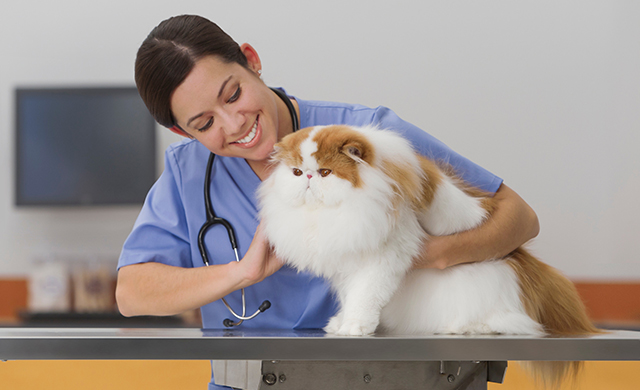
Floppy Ears, Short Noses – Your Pet’s Features May Need Special Care
07/03/2018 06:00AM | 9683 viewsThere are many physical features that make our pets so adorable and Instagramable – from floppy ears to goofy faces.
But many of those same features come with specific health considerations. Veterinary care is not one-size-fits-all. That’s why it’s so important to develop a relationship with a veterinarian you trust, so you can take proper care of your pet in every environment.
Banfield veterinarian Ari Zabell, based in Vancouver, WA, encourages pet owners to partner with a veterinarian to mitigate those risks as much as possible. He shared a few tips specific to certain types of pets.
Floppy-Eared Dogs
Dog breeds with floppy ears and breeds that swim a lot are at higher risk for ear infections, compared with other breeds. Proactively caring for your pet’s ears is important to reduce the chance of ear infections and excess wax build up. It starts by simply paying those ears some attention – examine, smell and clean them regularly.
As Dr. Zabell puts it: “When the ears smell like feet, it’s time to get them checked by a veterinarian.”
Banfield advises that you also look for:
- Discharge from the ear
- Excess scratching, pawing or rubbing at the ears, or just shaking the head a lot
- Redness in the ear canal
- Sensitivity or pain around the ears
- Ear swelling
- Masses around the ear area
To clean your dog’s ears at home,choose a mild ear cleaner specifically designed for pets. It’s best to avoid vinegar, alcohol and hydrogen peroxide, which can irritate the skin and be painful to an already inflamed ear canal.
Pick up an ear flap and fold it back, so you can see the opening of the ear canal. Place a generous amount of the ear cleaning solution into the ear – one of the rules of ear cleaning is that if you don’t make a mess, you probably aren’t doing it right! As the solution drips deep into the canal, gently massage the base of the ear for 10 to 20 seconds to help the wax and debris dissolve into the solution.
Be gentle! This step should not be painful for your pet. The ear canals and flaps are sensitive, and overly aggressive cleanings may cause serious damage to the delicate structures of your dog’s inner ear. After the fluid has been massaged into the ear canal, let your pet shake their head, this will get the cleaning solution and all the debris it has picked up back out of the canal, so you can wipe it free with a cotton ball or soft tissue.
Never use a Q-Tip on your pet. The earcanal is three to four times longer in a dog or cat than in a person, and it makes lots of twists and turns. Water, wax and debris can build up, and Q-Tips increase the risk of jamming the debris in further.
For more information, or if you have questions about your pet’s ear health, visit your veterinarian or read this Banfield article about cleaning and caring for your dog’s ears.
Short-Nosed Dog and Cat Breeds
Those smooshed faces and funny grunts sure are lovable, but keep in mind that short snouts come with all the usual nose parts – they’re just packed and arranged a bit differently, which can cause breathing complications.
Short-nosed – also known as brachycephalic– breeds are at risk of brachycephalic airway syndrome, a compromised airway due to a face shape that causes the nostril opening to be more narrow, along with other physical challenges that partially block the pet’s airway. These pets might have a harder time breathing, and they may also snore as a result.
Always be mindful of your pet’s respiratory issues, but pay special attention on hot days. Dogs don’t sweat – the way they cool themselves when overheated is by panting. But with short noses, the panting process isn’t as efficient – these dogs tend to pant harder, causing additional swelling and inflammation of the already constricted airway.
“On hot days, brachycephalicbreeds often come into the hospital over-heated, or even with heat-stroke, just from not having the ability to keep themselves cool enough,” said Dr. Zabell.
According to this handout from Banfield, breeds most at risk of brachycephalic airway syndrome include:
- English Bulldogs
- French Bulldogs
- Pugs
- Boston Terriers
- Boxers
- Shar Peis
- Shih Tzus
- Cavalier King Charles Spaniels
- Lhasa Apsos
- Pekinese
- Persian cats
- Himalayan cats
It is important to have your brachycephalic pet thoroughly examined by a veterinarian for a complete diagnosis and treatment plan throughout their life, not just when complications arise. Being proactive may decrease the development of irreversible changes in the airway, cardiac, and respiratory muscle structures.
Small Dogs
In practice, Dr. Zabell has also observed that many pet owners of small dogs, especially Chihuahuas, tend to overlook the importance of behavioral training. When a tiny, five-pound dog growls or bears its teeth, it’s easy to chuckle and characterize the behavior as “cute” or “sweet.” But it’s not so cute or sweet when they actually bite a person or pet.
“Small dogs can make great pets and are ideal for many lifestyles,” said Dr. Zabell. “But they often don’t get the training the big dogs get, which can pose significant safety risks – especially to children when a small dog jumps in to defend its family or gets frightened.” As sad as it is, unfortunately, one of the most common reasons pets are euthanized (put to sleep) is for behavior issues.
Regardless of your small dog’s manners, keep their vaccinations current – including Rabies, which is legally required in most if not all states. And if your dog demonstrates undesired behaviors, especially protective or aggressive, ask your veterinarian for pet behaviorist recommendations.
The bottom line: We all want our pets to live happy, healthy, well-adjusted lives. The key to achieving that is to being proactive in your pet’s care, one part of which is building a relationship with a veterinarian you trust.











Post your Comment
Please login or sign up to comment
Comments